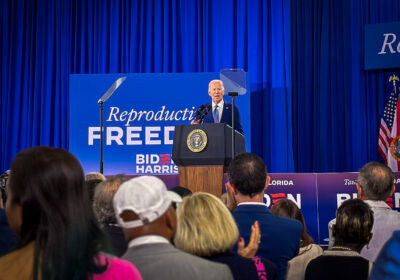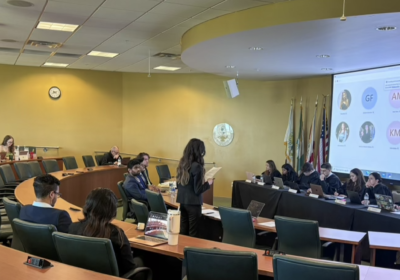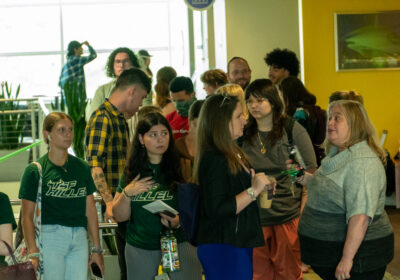Students race robots in the classroom
What was once science fiction is slowly becoming science fact, especially when it comes to robotics.
For the first time, students in the Mechanical Engineering II class had the opportunity to cross disciplines and compete with one another in a robot competition.
“Engineering is becoming more and more interdisciplinary,” Jonathan Gaines, an associate professor and the instructor for the course, said. “Mechanical engineers are increasingly asked to know more and more, and there are lots of opportunities in robotics right now.”
Students using pre-built robots purchased by the engineering department met in the Interdisciplinary Sciences Lab during their normal class time.
Instead of a lecture, the students were pitted against one another to see who could travel the octagon-shaped course in the least amount of time.
“The robots have built-in infrared systems that will detect the wall and navigate along the edge of the wall without students having to control it,” Gaines said. “They’ll just hit the switch and it goes.”
The challenge for students was programming the robot to follow the boundaries of the course and not to smash in to the wall.
“They basically had two different lab segments: one where they got acquainted with programming and programming software, and then this one where they actually use their program in the real world,” Gaines said.
Typically a job for computer engineers and coders, mechanical engineering students learned how to program their robots using a coding program called LabVIEW. The program allows students to code graphically, allowing them to see how the robot will move as they change the code.
At the competition, students realized computer engineering was more of a challenge than they originally thought.
The majority of the student groups were unable to get their robots around the octagon, many of them crashing into walls or rolling away from the track.
Meet Doshi, a senior majoring in mechanical engineering, had never programmed anything before the lab. Doshi said he was able to get more out of the lab because it was hands-on and not just theory.
“Working with infrared sensors was totally new to me and now I feel like I have a grasp on it,” he said. “It just goes to show that you can’t just be one specific type of engineer, you have to dip your hands into every aspect.”
Douglas Blake, a senior majoring in mechanical engineering, was one of the few students whose robot made it all the way around the octagon, completing the task in 27 seconds.
Blake said he thinks the skills he learned while programming the robot has made him more prepared for the job market when he graduates.
“Mechanical engineers, especially those doing robotics, are increasingly being asked to have more interdisciplinary skills,” Blake said. “Everything we work with is going to have motors and sensors and programs. We can’t just be strictly mechanical engineers anymore.”
The next time the class meets in the lab, they will place obstacles inside of the octagon track and learn how to program the robots to avoid them.
Gaines said he hopes to show students how much they can do with engineering.
“This lab we are meeting in is a shared space between all the different engineering disciplines,” he said. “The best thing about this exercise is that it really encourages mechanical engineering students to go beyond mechanics and get a feel for everything that’s in the field.”






